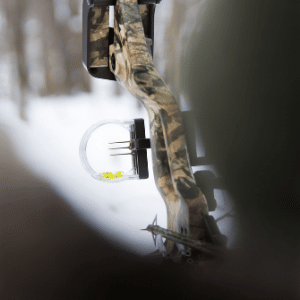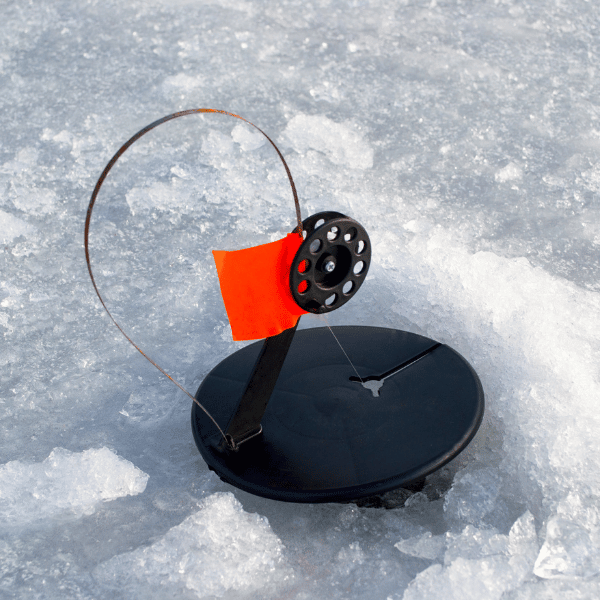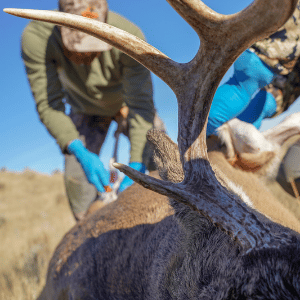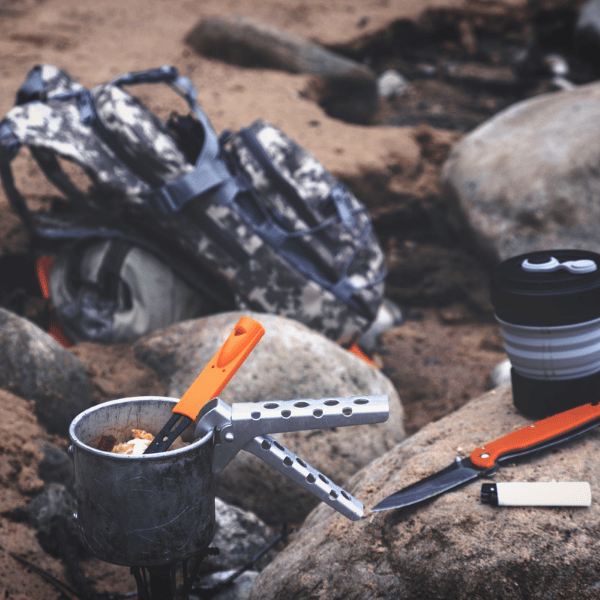How to Fillet a Walleye (Step by Step)
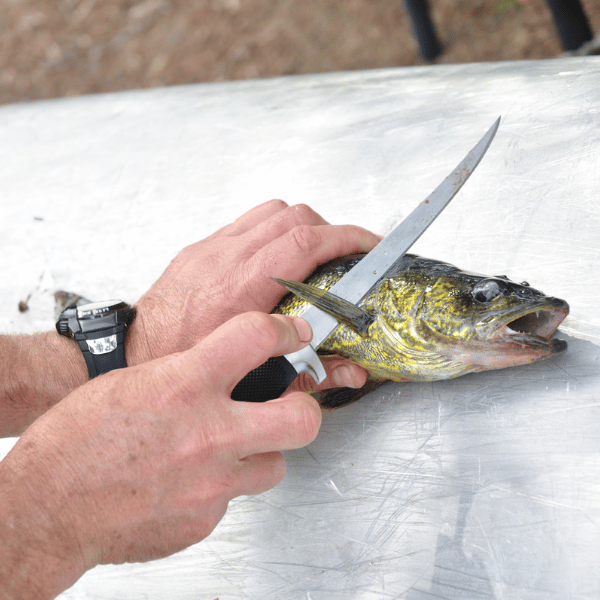
The best way to fillet boneless walleye is with an electric knife, cutting behind the front ventral fins and ride the spine and ribs back. However, electric fillet knives can be too aggressive for beginners, so opting for a sharp classic fillet knife is best and uses the same fillet technique.
This article will discuss the best knives to fillet walleye and a step-by-step guide on how to fillet boneless walleye.
Contents
Best Type of Knife to Fillet Walleye
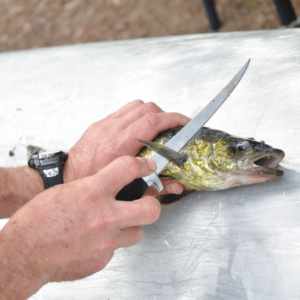
Walleye, one of the best-tasting fish, can be very difficult to fillet. These fish have Y and lateral-line bones that may need a certain knife to get around. So, before we get started on how to fillet a walleye, we have given you a small life of knives that would be a good choice to start with.
Look for these qualities in a fillet knife:
- Premium steel
- Non-slip grip
- Razor-sharp
- Flexibility
- Proper size
- Corrosion-resistance
Below are a few of the best walleye fillet knives.
Mercer Culinary Millennia Narrow Fillet Knife
The top choice for many, in both professional and at-home use. This knife is forged with Japanese stainless steel to provide unrivaled performance. This single piece of steel will not suffer from corrosion, rust, or discoloration. The blade is flexible and narrow, which allows for an effortless fillet.
The handle is made of Santoprene, which features a non-slip grip that can handle harsh exposure. The material is imprinted with texture fingerprints to create a comfortable grip that minimizes fatigue. You will also appreciate the hassle-free maintenance and overall durability and strength.
The Mercer culinary narrow fillet knife has sturdy build quality offered at an unbeatable price. This is a great bang for your buck if you are looking for a new fillet knife.
Morakniv Fishing Comfort Fillet Knife
If you are wondering how you fillet a walleye, get a Morakniv fillet knife. It has good edge retention and corrosion resistance. Along with a decent size and reasonable price too.
When handling this knife, you will feel the high-friction patterned handle. Taking a look at the sheath, you will find that it can be attached to a belt loop or be clipped on. The sheath is easy to clean if you are worried about that.
The blade is manufactured from Sandvik stainless steel and is 2 mm thick. It comes in two sizes, but we recommend only purchasing the 6.1-inch length. This blade will not corrode, and you will be surprised by how sharp it is.
The best part about this knife is its versatility and lightness, which makes it ideal for any type of outdoor activity.
Rapala 5 Soft Grip Fillet Knife
The Rapala 5 is known for its handle and flexible blade while being a budget option. Include with the knife if a sharpener, not the best, but still wonderful to have when needed. It features a thin blade that has a range between 4 to 9 inches, depending on the model.
The blade is perfect for slicing every last piece of meat from the bone. This knife will be excellent to use on poultry as well. Keeping it, sharpened should never be a problem.
The thermoplastic handle is one of the highlights of this knife. It is textured, soft, and comfortable, allowing you to use it without pain. Any knife from the Rapala brand is going to be a good choice, so do not hesitate if you like what they offer.
How to Fillet Boneless Walleye
Step-by-Step Guide
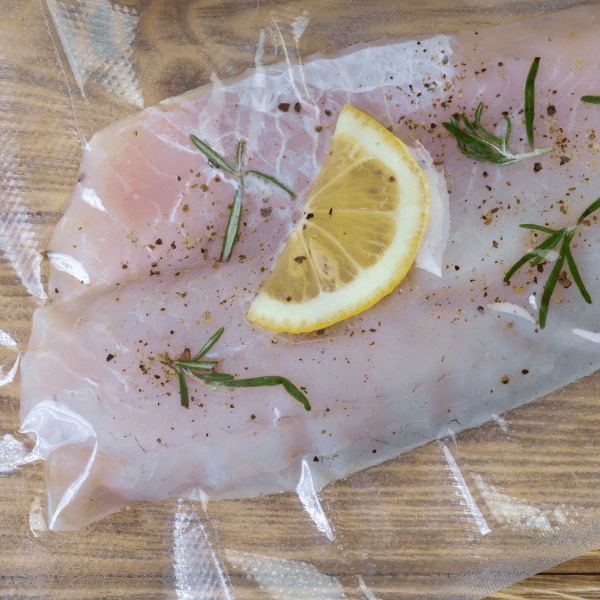
Walleyes are some of the highly sought fish in a lake. Their taste is not overpowered by fishiness, and their fillets are flaky and leave a savory feel in your mouth. Below are instructions on how to fillet for a right-handed person. If you are left-handed just flip everything around 180 degrees.
- The starting process is the same as most fish, the head on your left and belly facing you. Slice the fish behind the pectoral fin and go all the way to the backbone.
- While keeping the pressure on the backbone, turn the knife and cut towards the tail. You will cut through the rib cage and out through the tail. You should then have a piece of fish with the rib cage still intact.
- Flip the fish over, so the head is still facing the left. Make another cut behind this pectoral fin. Then make the same cut following the backbone down through the tell. After this, you should have two nice sized fillets with the rib bones inside them.
- Now it’s time for the rib cage, which can be tricky. Place the filet with the skin down and rib cage up and facing away. Make your initial incision down into the middle of the filet along the rib cage.
- Once you get past the rib cage, you can carefully slice away from you around the rib cage, or you can use the knife to push up from under the rib cage. The rib cage should pull away from the rest of the fillet.
- Repeat this process with the other fillet you have.
- Now you will have to remove the Y bones. These are along the rib cage where you just cut. It is recommended to use your finger to feel where they are if this is new to you.
- Make two small parallel cuts that come to a point where the Y bones end. This should remove the thin strip of fish that contains the Y bones.
- Now all that is left is the skin, which can be left on if you choose to do so.
- Make a small slice down into the fish at the end where the tail would be. Angle the knife towards the skin, which should be facing down. While pulling away from the knife with your left hand, use your right hand to saw gently.
- The knife should slide through the meat fairly easily if you have a sharp knife.
- You now have a boneless and skinless fillet ready to cook or vacuum seal to store in the freezer for a later date.
As with any activity, this will take time to learn. If you do need more help visualizing this process, I recommend checking out some video tutorials on YouTube. There are tons of them, and who knows, you may just learn a neat trick or two from watching them.
Final Tip: Keep the Fillet Knife Sharp
There are many factors that come into play when filleting a fish, especially and walleye. It is crucial that you have a quality knife that is also sharpened. You will be cutting through bones while near your fingers, and a slip can cause serious injury.
Boneless Walleye Fillet FAQ
No, you can leave the scales on if you choose to do so. Most people will recommend descaling though. If you plan on descaling the fish, it is easiest to do before the fish is frozen. Once frozen the scales are much harder to get off.
Yes! The skin is safe to eat. In fact, some individuals prefer walleye with the skin on. If you want the skin off, it is a simple cut. Try it both ways and try different cook styles to find what you prefer most.
ou will follow the same instructions above. The electric knife makes it, so you do not have to put as much effort into a sawing motion. For the most accurate and precise cuts, a regular knife is recommended. If you are looking for a quality electric knife, below is a small review of one that we find the best.



